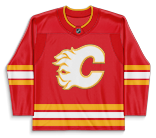Sabourin will make his first appearance as a San Jose Shark as Kevin Labanc is the odd-man out on Tuesday. Sabourin has nine goals and four assists in 29 games with the San Jose Barracuda (AHL) this season.

Sabourin will make his first appearance as a San Jose Shark as Kevin Labanc is the odd-man out on Tuesday. Sabourin has nine goals and four assists in 29 games with the San Jose Barracuda (AHL) this season.

Labanc will sit in favour of Scott Sabourin, who will make his Sharks' debut on Tuesday. Labanc has one goal and five assists in 28 games this season.

Okhotyuk will take a seat on Tuesday as Kyle Burroughs is set to return from a lower-body injury. Okhotyuk has no goals and six assists in 28 games this season.

Robertson will take the place of Noah Gregor who will miss Tuesday's game against his former team with an illness. Robertson has five goals and six assists in 24 games this season.

Juulsen was a healthy scratch for the Canucks first game of their back-to-back Monday but will draw back into their lineup Tuesday vs. New York. The 26-year-old will replace Ian Cole (maintenance) and has yet to score in 26 games in 2023-24, but has two assists, 12 PIMs and 11 SOG.

Dysdale was traded for Cutter Gauthier is a surprise deal Monday and is expected to make his Flyers' debut Wednesday vs. Montreal as he partners with Travis Sanheim. The 21-year-old offensive defensemen heads to Philly after collecting five points (1G/4A) in 10 games after missing most of the early season due to a tornn labrum injury.

Dube has been ineffective while playing in all but one game for the Flames so far this season, scoring only seven points (3G / 4A) in 39 contests. His 0.18 point-per-game pace is the lowest of his six-year career and a significant decline over the 0.55 point-per-game pace he had last season.

Kuznetsov was recalled last week but could not crack the Flames roster and immediately returned to the Wranglers (AHL), where he has seven points (2G / 5A) in 31 games this season. That said, the Flames defensive prospect will make his NHL debut at home on Tuesday against the Ottawa Senators.

Clarke was service in his season debut on Sunday, recording one shot on goal and one hit in 15:43 time-on-ice but will draw out of the lineup in favour of Jordan Spence on Tuesday against the Tampa Bay Lightning. Before his call-up last week, he spent the entirety of this season with the Ontario Reign of the AHL, amassing 32 points (7G / 25A) in 30 games.

Spence will re-enter the lineup for the Kings as Brandt Clarke will be a healthy scratch on Tuesday. Before coming out of the lineup on Sunday, Spencer played nearly every game for the Kings over the last three months, scoring 12 points (0G / 12A) while averaging 15:11 time-on-ice through 34 games.

Pitlick will make his season debut and team debut with the Blackhawks on Tuesday against the Edmonton Oilers. The 26-year-old Pitlick has been an effective contributor at the NHL level in the past, scoring 54 points (21G / 33A) in 123 games, but has played exclusively in the AHL thus far this season, scoring 24 points (8G / 16A) in 32 games with the Wilkes-Barre/Scranton Penguins.

Phillips played only 5:56 time-on-ice on Sunday, his first game action in five games, recording a -1 plus/minus rating. He will be a healthy scratch for the Blackhawks on Tuesday against the Edmonton Oilers.

Taylor Raddysh's return to the lineup has prompted the Blackhawks to make Johnson a healthy scratch on Tuesday. Johnson is averaging 11:20 time-on-ice through 27 games for the Blackhawks this season, scoring two points (2G / 0A) and 56 hits.

Adam Pelech is expected to make his return to the lineup for the Islanders on Tuesday, making Bolduc a healthy scratch. Bolduc has played each of the last 18 games for the Islanders, registering three points (1G / 2A) while averaging 14:50 time-on-ice.

Malinski has had some success with the Avalanche earlier this season and will get another chance to showcase his talents as he was recalled on an emergency basis on Monday. In 14 games with the Avalanche, Malinski has five points (1G / 4A), 15 shots, and 15 blocks.

Polin has yet to play an NHL game after signing out of Western Michigan University last season. In 20 games with the Colorado Eagles of the AHL, Polin has two points (0G / 2A) and 19 penalty minutes.

Meyers will be a healthy scratch on Monday as Jason Polin is set to make his NHL debut. Meyers has one goal and no assists in nine games this season.

John Beecher is expected to draw back into the lineup on Monday, prompting the Bruins to make Lauko a healthy scratch. The 23-year-old Lauko is averaging 9:25 time-on-ice and has three points and 48 hits through 28 games this season.

Jakub Lauko will be a healthy scratch on Monday, allowing Beecher to re-enter the lineup for the Bruins. Beecher has six points (4G / 2A) in 35 games this season and is expected to play on the fourth line with Jesper Boqvist and Oskar Steen.

Petan played the last four games for Minnesota but will exit the lineup for Monday's contest against the Dallas Stars. In those four games, Petan recorded two points (0G / 2A), seven shots, and one hit.
